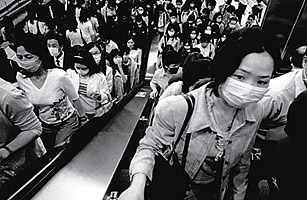
Taiwan, 2003. Commuters in Taipei take precautions at the height of the SARS epidemic.
(2 of 3)
A News Blackout Takes Hold
Within days, however, the virus seemed to be everywhere. Mainland rumors became a Hong Kong reality as hospitals were overwhelmed with contagious patients who were deteriorating in just 24 hours from high fever to oxygen deprivation. The epidemic was missing from the headlines, however, because the Chinese government had imposed a news blackout. As the first cases were reported on the eve of the Chinese New Year, the province of Guangdong's Communist Party secretary, Zhang Dejiang, shut down media coverage, lest the panic cut down on the huge sums that Chinese spend on food and travel during the holiday festivals. As he explained to his deputy, according to a source who requested anonymity, "If the newspapers are not going to responsibly cover the matter, then why should we let them write about it?" This pattern of local and then national officials' covering up the extent of the outbreak and refusing to share data with international health agencies would be partly to blame for the spread of the virus. It would eventually reach 37 countries and acquire a name: severe acute respiratory syndrome (SARS).
As Zhang enforced his news blackout, other top party officials in the province were receiving an envelope marked "neibu," or "top secret," and signed by the Guangdong provincial health bureau. Inside was a document explaining that the new disease was highly infectious and recommending isolation of patients and other stringent infection-control measures. Medical staff, it went on, should wear masks, goggles and gloves and be aware that the disease could be passed on by airborne particles. In other words, circulating in the Chinese government at that moment was a document that could have told hospitals around the world — and in stricken Hong Kong — exactly what protocols Chinese hospitals had developed as they grappled with this novel virus. Most Chinese doctors and nurses never saw the document, as it was considered too politically dangerous for wide distribution.
Such obfuscation became a recurring pattern: we would hear reports or rumors of cases in certain hospitals, and then the Chinese Ministry of Health would deny the existence of any cases. Our reporters began what we called bombing: walking into a hospital, asking the staff if there were any SARS cases and then counting the number of patients. Meanwhile, World Health Organization officials were repeatedly stonewalled by the Ministry of Health, whose officials, in the words of WHO epidemiologist Hitoshi Oshitani, "still thought they could cover up and the disease would be gone in a few weeks."
The cover-up might have continued if not for the courage of a retired Chinese doctor and party member, Jiang Yanyong, who met with one of our reporters, Susan Jakes, and described hundreds of cases in Beijing hospitals. Yet the Chinese government was still insisting there was no SARS in Beijing. International outrage at this dissembling reached a point at which even the Chinese government felt compelled to act. On the afternoon when I was walking through the deserted shopping mall, I received a phone call from Jakes. She described a press conference at which it was announced that the Chinese Minister of Health and Beijing's mayor had just been purged. At the same time, the Deputy Minister of Health revised the number of estimated SARS cases in China to more than 2,000, up from just 350 the day before. The Chinese government, in part because of TIME's reporting, had for the first time purged a high official in response to international pressure, as opposed to internal machinations. And then it canceled May Day festivities.
Almost as soon as we were aware the disease was in our midst, the virus had already managed to reach Beijing, Toronto, Vancouver, Hanoi, Taipei and Singapore. The disease was confounding in that it seemed to use the hospital system as a vector. As sick patients were hospitalized, the treatment given, usually a nebulizer that could open up clogged lung passages, actually disseminated the virus further. Then, just as quickly as the disease burned into our consciousness, it dissipated. The pandemic that we feared never materialized; the disease turned out to be quite deadly but less contagious than was first believed. Better infection control and strict quarantine of infected patients slowed the onslaught. Scientists at Hong Kong University, led by microbiologists Malik Peiris and K.Y. Yuen, successfully isolated and identified the virus; other heroic doctors in Hong Kong determined through trial and error what was in that top-secret Chinese memo they had never seen. And HKU microbiologist Guan Yi deduced that the virus had emerged in the wild-animal markets of southern China, where hundreds of species are imported to feed the millions of migrant workers who congregate in some of the most crowded cities on earth.